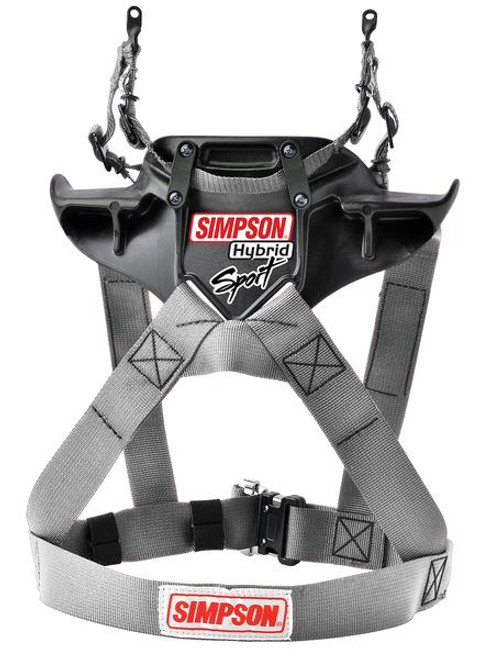Product Description
- Click here for Sizing Chart.
-
The Hybrid S Head Restraint is FIA and SFI approved and is tested and shown to be compatible with 3-point harnesses used by Car Club enthusiasts and High Performance Driving Experiences. This allows Driving Instructors, Auto Manufacturing Test Engineers, and other cars with 3-point harnesses to have added protection. We are pleased to offer protection to this sector of the market, however, Simpson’s top concern is your safety. While on a racetrack for the BEST protection we suggest a Full-Containment Cockpit System that includes a, Full Containment Seat, Snell rated Helmet, FIA or SFI approved Head Restraint, and Simpson 7 point seatbelt harness system.
- FIA and SFI Approved
- High quality carbon fiber construction
- Low profile. No high back to hook on the bars on exit
- Multiple load paths to dissipate head loads
- Buckle attachment in front. No bulky straps underneath
- Installation manual
Click here for a webinar on using the Hybrid S with 3-point belt systems.
To Install a Hybrid S into a 3 point seat belt system, the SAS, Seat Belt Anchoring System, are not used.
-
(The SAS straps anchor loops hook into the seat belt buckle in a 5, 6 or Simpson 7 point set of seat belts in a Race Car.)
Just as in a Race Seat installation, the occupant puts on the Hybrid S and gets into the seat. Follow the instructions on fitting the device to the wearer.
- Hook up the 3 point belt and sit in your normal driving position.
- Have a helper, apply gentle pressure to the shoulder pads on the top of the device. This will keep the device stable during the tether adjustment procedure. The device should be in a comfortable position behind the driver’s back, against the seat cushion. If the device is uncomfortable in the seat, a device pad can purchased that will attach to the back of the seat and provide a slot for the device to sit. This is not normally needed for the use in a soft back seat such as in a passenger car or HPDE.
- To adjust the Helmet Tethers:
- While your helper is holding the device in it’s location and the wearer is looking straight forward, hold the triangulated tether up to the side of the wearer’s helmet. Adjust the side tethers so that the tether end fitting can be easily inserted into the helmet anchor without having it apply downward pressure to the helmet. A comfortable adjustment on the side tether is to have about an additional ¼” of slack in the tethers at this point.
- With your helper still holding the device down and the wearer looking straight forward, adjust the rear tethers so that there is between ½” to 1” of slack in the rear tether. Test the amount of head movement by moving the head Straight Forward. The wearer should have between ½” to 2” of Straight Forward head movement before the slack is taken out of the tether system. Remember when checking this, not to rotate the head down, but translate it straight forward. This should be plenty of head movement to be able to drive the car for on track activities.

-

-

 British Pounds
British Pounds
 EU
EU
 USD
USD


























